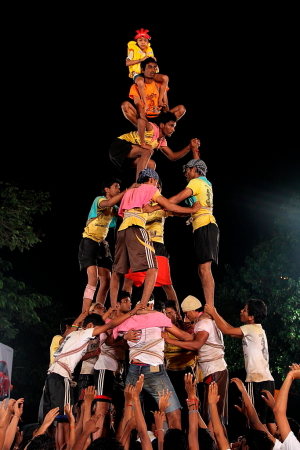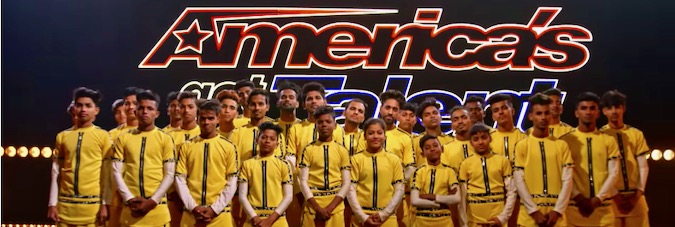SATURDAY, AUGUST 24: Americans love the acrobatic feats of the Indian dance crew V. Unbeatable on America’s Got Talent. The crew has racked up more than 25 million views of their AGT video clip! (We’ve got that video, below.)

A dahi handi pyramid in India for Krishna Janmashtami. Photo by Akshay Charegaonkar, courtesy of Fllickr
On August 24, 2019, you’ll see some of the real-life origins of this death-defying cultural expression in Dahi Handi, a hugely popular part of Krishna birthday festivals. In city streets across India, men form towering human pyramids. Around the holiday, type “Dahi Handi” into Google-News and you’ll spot stories and videos of this colorful custom. In recent years, news stories also report efforts to protect these eager participants. Every year, people are injured in these efforts.
The holiday honors the birth of Lord Krishna. Millions will fast as well as indulge in sweets, chant and celebrate. The observance of Krishna Janmashtami lasts eight days in some regions!
The Hindu deity Krishna is also known as the eighth avatar of Vishnu. To devotees, Krishna is the epitome of many characteristics: according to ancient texts, he is a mischievous and fun-loving child, a romantic lover and an empathetic friend.
On Krishna’s birthday, events begin before sunrise and last through midnight. Public and private prayer, both in centuries-old temples and in private homes, can include chanting and singing. Feasts of many dishes are prepared, and dances and dramas depicting the life and ways of Krishna are watched with fanfare. Some devotees dress or decorate statues of Krishna, while others string garlands across temples.
Many Hindus fast until midnight—the official birth time of Krishna. At midnight, those at the temple watch a priest pull apart curtains to reveal a fully dressed figure of Krishna.
A BIRTHDAY CELEBRATION: FROM MUMBAI TO NEPAL

At a celebration for Krishna Janmashtami, 2017. Photo by Ramakrishna Math and Ramakrishna Mission Belur Math, courtesy of Flickr
Across India, Krishna’s birthday is commemorated with regional variations. In Mumbai, Pune and in other regions, boys form human pyramids in hopes of having the highest boy break an earthen pot (called a handi) filled with buttermilk, which is tied to a string strung high above the streets. If the pot is broken, buttermilk spills over the group and the boys win prize money. Various groups of boys compete in Dahi Handi, in impersonation of a favorite pastime of the child Krishna: stealing butter. Today, political figures, wealthy individuals and even Bollywood actors contribute to prize money for the Dahi Handi. In some regions of India, younger boys—typically the youngest male in a family—is dressed up like Lord Krishna on Janmashtami. Hindus across Nepal, the U.S., Caribbean and more revel in festivities for Krishna Janmashtami, offering fruit, flowers and coins to the deity and chanting together.
FROM HOME: HOW TO CELEBRATE
Devotees can celebrate Krishna Janmashtami at home, too, with suggestions from Krishna.com:
- Invite friends and family to participate in festivities
- Decorate your home for Krisnha with garlands, clothed figures and balloons
- Check out the webcam views at Krishna.com, which capture temple festivities
